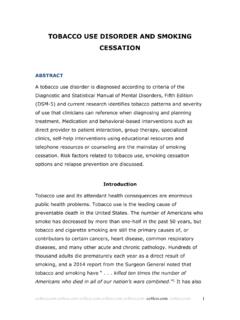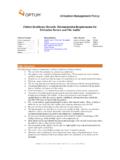Transcription of California Law & Ethics 18 Hours - Ce4less
1 California Law & Ethics 18 Hours chapter 1 1) The core values of social work include all except a) Service b) Social Justice c) Beneficence d) Competence 2) The Statutes and Regulations Relating to the Practice of Marriage and Family Therapy, Educational Psychology, and Clinical Social Work was developed by the a) Association of Therapy Boards b) National Institute of Mental Health c) California Therapy Consortium d) California Board of Behavioral Sciences 3) MFT applicants licensed after 2004 must have additional coursework in a) aging and long-term care b) pain management c) carbon credits d) medical errors 4) Clinical social work applicants must have specific training in all the following except a) alcoholism and other chemical substance dependency b) spousal or partner abuse c) personality testing d) human sexuality 5) Confidentiality is a/an _____ issue.
2 A) Therapeutic b) Legal c) Ethical d) all the above 6) The NASW Code of Ethics states that social workers should protect the confidentiality of all information obtained in the course of professional service except for compelling professional reasons. a) True b) False 7) Under California law, the primary exceptions to confidentiality concern a) the age of the patient b) the service setting c) whether there is a court order for the information d) harm to self or others 8) In group therapy, the mental health provider must guarantee that group members will keep information confidential. a) True b) False 9) If a provider receives a subpoena from an attorney to provide copies of clinical records, he or she may claim privilege on behalf of the client.
3 A) True b) False 10) The California Family Code 6924 states that a minor who is _____ years of age or older may consent to mental health treatment if certain requirements are met. a) 10 b) 12 c) 14 d) 16 11) Minors are able to consent to psychotropic medications without parental consent. a) True b) False 12) Mental health providers may not disclose medical records without the written consent of the minor patient. a) True b) False 13) What term describes professionals who work with vulnerable populations and are required to report suspicions of abuse? a) Good Samaritan b) Designated Participant c) Mandated Reporter d) Professional Receptor 14) The first child abuse and reporting law was enacted in California in a) 1943 b) 1953 c) 1963 d) 1973 15) Psychotherapists must make a report of child abuse whenever a _____ of abuse exists.
4 A) Preponderance of the evidence b) Hint c) Reasonable suspicion d) Signpost 16) After a mental health professional reports abuse, they must prepare a written report within _____ Hours of the initial report. a) 6 b) 12 c) 24 d) 36 17) Which is NOT mentioned as a sign of elder abuse? a) Caregiver not wanting elder to be seen on his/her own b) Observable behaviors such as anger and substance abuse c) Dependence of caregiver on elder for financial support d) Caregiver is a minor 18) Which allows California counties to decide whether to implement a community-based, court-monitored outpatient treatment program? a) Laura's Law b) Amy's Law c) Megan's Law d) Amber's Law 19) Which is not a criteria for placing a person in assisted outpatient treatment?
5 A) has a co-occurring addictive illness b) is eighteen years of age or older c) is suffering from a mental illness d) is unlikely to survive safely in the community without supervision 20) Only the _____ may file a petition for assisted outpatient treatment. a) county mental health director b) county attorney c) family members d) mental health provider 21) In the 1976 rehearing of the Tarasoff case, the California Supreme Court called for a _____ for the intended victim. a) Right to accuse b) Right to retribution c) Duty to Notify d) Duty to Protect 22) In the Ewing case, the court requires to take into consideration information from _____ in deciding whether to notify intended victims. a) journals b) unconscious material c) family members d) social networking sites 23) In California , the therapist must respond to threats learned of from a) Social Media b) Family Members c) A patient's friends d) A patient's teacher 24) In the Ewing case, the court requires to take into consideration information from _____ in deciding whether to notify intended victims.
6 A) journals b) unconscious material c) family members d) social networking sites 25) Which is described as perhaps the most important of the components in developing cultural competence? a) Knowledge of the client's culture b) Immersion in a practicum setting c) Professional skills d) Personal attributes of the counselor 26) Knapp and VandeCreek (2012) refer to informed consent as a) common-sense permission b) priming the pump c) ringing the doorbell d) empowered collaboration 27) Which is a consumer watchdog agency which has provided a definition of informed consent? a) Consumer Reports b) California Patient s Guide c) California Public Interest Research Counsel d) The Patient s Friend 28) Informed consent generally includes a) Approximate length of the process b) Alternatives to therapy c) Treatment procedures d) All of the above 29) Which was mentioned as an example of a dual relationship?
7 A) counseling someone previously known to the therapist b) counseling a family member c) entering a business relationship with a client d) all the above 30) Which does Fry list as an extreme consequence of boundary violations? a) Co-worker frustrations b) Burnout c) Compassion fatigue d) Loss of professional identity 31) Sexual contact with former patients within _____ after termination of therapy is illegal and unethical. a) 1 year b) 2 years c) 5 years d) Sexual contact with former patients is never legal 32) What percent of therapists report that they have experienced sexual attraction to clients? a) 62% b) 72% c) 82% d) 92% 33) Pope found that harm occurred in at least _____ of the instances in which therapists engaged in sex with a patient after termination.
8 A) 70% b) 80% c) 90% d) 100% 34) Any therapist in California who learns from a patient that the patient has had a sexual relationship with a psychotherapist during treatment is legally obligated to give the patient the brochure Professional Therapy Never Includes Sex . a) True b) False 35) The California Mental Health Parity Law applies to all of the following EXCEPT a) Schizophrenia b) Personality disorders c) Major depressive disorders d) Panic disorder chapter 2 36) An estimated _____ cases of intimate partner violence are reported each year. a) million b) million c) million d) million 37) Prior to about the _____, domestic violence was seen as a normal part of marriage or intimate relationships. a) 1950s b) 1960s c) 1970s d) 1980s 38) In 2007, intimate partners committed _____ of all homicides in the a) 4% b) 14% c) 24% d) 34% 39) Which is not mentioned as a common warning sign of intimate partner homicide?
9 A) Previous police involvement b) History of mental illness c) Recent unemployment d) History of drug or alcohol abuse 40) Which victims of domestic abuse are more likely to report violent conflicts? a) Male b) Elderly c) Female d) Teen 41) Which policies allow the greatest leniency when confronted with domestic violence? a) Warrantless arrest policies b) Discretionary arrest policies c) Mandatory arrest policies d) Preferred arrest policies 42) The overall feeling is that _____ policies can be detrimental to victims of intimate partner abuse. a) Dual arrest b) No fault c) Don t ask, don t tell d) Zero tolerance 43) The first step of advocacy is a) Establishing confidentiality b) Validating the violence c) Acknowledging the injustice d) Empowering advocacy 44) Advocates in an Office of Victim Services might provide all the following EXCEPT a) Act as a liaison between victims and court personnel b) Provide crisis counseling c) Advocate for victims during court proceedings d) Provide victims with social service referrals 45) In California , victims of domestic violence must complete which forms?
10 A) PFH-2 and PFH-1 b) PFH-1 and DV-100 c) DV-100 and CLETS d) CLETS and PFH-2 46) Which makes protection orders enforceable across state lines? a) And Justice for All b) The Omnibus Domestic Violence Act c) Federal Violence Against Women Act d) The Interstate Violence Act of 2004 47) Which are short-term, family-focused, and community-based services designed to help families cope with stresses that interfere with their ability to nurture their children? a) Child protective services b) Family preservation services c) Child guidance services d) Family support services 48) All states have passed some form of mandatory child abuse and neglect reporting law in order to qualify for funding under the a) FANDANGO b) CAPTA c) EBITDA d) JAWAS 49) Which is a part of the domestic violence safety plan?







